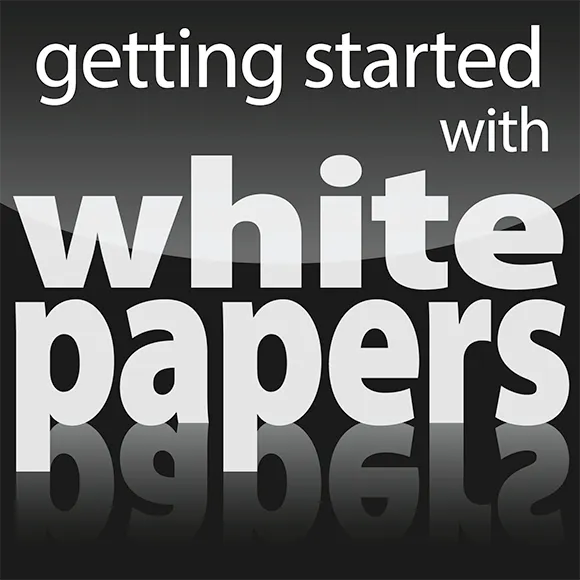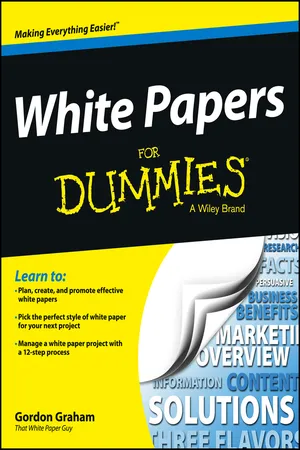Part I
Getting Started with White Papers
Visit
www.dummies.com for access to great Dummies content online.
In this part . . .
See how white papers are revolutionizing B2B marketing.
Find out how the demand for white paper writers outweighs the supply and how much you can earn writing them.
Take a look at how white papers are shaping decision making today and how they’re likely to influence business practices in the future.
Discover who writes and reads white papers, when it makes sense to use these persuasive essays, and how to figure out if you need one.
Chapter 1
Unleashing the Power of White Papers
In This Chapter
Getting familiar with the ultimate form of content: white papers
Acknowledging trends and avoiding typical problems with white papers
Tracing the rise of white papers in business-to-business marketing
Using white papers at the top, middle, and bottom of the sales funnel
Understanding which sectors use white papers today and which others could
Have you ever had to look into buying something big for your company? I’m not talking about an espresso machine for the lunchroom; I mean something really big. Something like when your boss calls you into his office and says, “We’ve got a problem. We’ve got to find a way to get our team out from under all this paper. We’re drowning in it.” And he wants you to dig into the problem and report back with some suggestions by Friday. Gulp.
What do you do? If you’re like most people, you head to your desk and start madly searching the web for phrases like “buried in paper” or “paper burden.” You skim down the search results until you see something promising. You click on the link and go to a web page — and what do you find? Ideally, you find a thoughtful examination of your problem with some useful tips on how to overcome it, most often in a document called a white paper. Armed with a few good white papers, you can prepare to make your report.
The same scenario happens every day in companies all over the world. Businesses buy loads of things, and business people need help deciding what to buy. An effective white paper is the best source for this kind of help.
In this chapter, I introduce you to white papers and show how business people use these documents to help select products and services worth many billions of dollars a year. I describe how any business that sells to other businesses can benefit by using white papers in its marketing. Whether you’re a marketing person or a copywriter, this chapter shows how you can benefit from the amazing power and reach of white papers, which are truly the “king of content.”
Seeing a White Paper for What It Is
Maybe you’re already familiar with white papers because you’ve read them or even written one or two yourself. Or maybe you have a fuzzy idea about white papers but aren’t sure how to describe them. Here’s the definition I use:
A white paper is a persuasive essay that uses facts and logic to promote a certain product, service, or solution to a problem.
Notice the key elements in this definition. A white paper is persuasive but somewhat formal like an essay because it uses facts and logic to make its points and to promote some product, service, or solution.
And here’s what a white paper isn’t. A white paper isn’t a sales pitch. A white paper isn’t an advertisement, brochure, case study, direct mail piece, or flier. It doesn’t have a “Buy Now” button. It doesn’t say how good you’ll feel to see your new purchase sitting in your office.
Instead of a sales pitch, an effective white paper provides useful, practical, and educational content. Companies use white papers to generate leads, nurture prospects, and build mindshare (as I describe in more detail later in this chapter).
Of course, every white paper must be tailored to a specific audience and a desired outcome. To make that easier for you, this book identifies three basic types of white papers and shows how to use each one in different situations. And to make the writing experience as smooth as possible, I outline my 12-step process that takes you through a white paper’s creation from start to finish.
Getting the scoop on the three flavors of white papers
You may think there are many types of white papers with subtle variations that make them hard to tell apart. In fact, there are only three main flavors of white papers, plus the mixtures between them. And they’re as simple to tell apart as vanilla, strawberry, and chocolate ice cream.
A
backgrounder is an old-fashioned type of white paper that focuses on the features, functions, benefits, and payback of a product or service from one vendor. You can say this flavor “zooms in” on one offering to describe it in depth. A backgrounder is so simple, classic, and predictable that I think of it as vanilla ice cream (more on that in
Chapter 6).
A
numbered list is a lively set of questions, points, issues, or tips about a certain topic. This format is extremely popular and easy to skim. And you can combine it with either of the other two types of white papers. Because a numbered list is so light and easy to digest, I like to compare it to strawberry ice cream (to see what I mean, skip to
Chapter 7).
A
problem/solution is a factual discussion of a major problem that has never been solved. It considers the scope of the problem, describes the existing solutions and their drawbacks, and recommends a new, improved solution for best results. You can say this flavor “zooms out” to give a high-level overview of an entire industry. The problem/solution is the hardest-working and longest-lasting white paper of all. And a problem/solution white paper is so rich and long lasting that I compare it to chocolate ice cream (see
Chapter 8 for details).
Following a proven system for creating white papers
Doing a white paper is a big, challenging project, far tougher than writing a blog or a sales letter. A white paper must be packed with research and useful information and run at least five pages with an attractive design. Many people are involved, and many things can go wrong. To help you keep all your white paper projects on track and avoid making common mistakes, I provide a 12-step process for planning and producing a white paper — the very same process I use with my own clients. Here’s how it goes:
1. Assemble the team. Pull together all the people you need to complete the white paper, such as a writer, a designer, an illustrator, subject matter experts, and reviewers.
2. Hold the initial conference call. Discuss the project and get everyone on the same page. If any differences arise, sort them out now to avoid surprises later.
3. Prepare the plan. Write up a brief plan for the white paper. Circulate and tweak it until all reviewers approve.
4. Gather your research. Take a deep dive into the subject through company background, web research, and interviews with experts.
5. Prepare an executive summary. Write a one-page summary of the white paper’s proposed direction. Circulate it until all reviewers approve.
6. C...


















